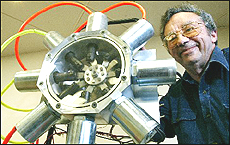
Radial Electric Motor
Taken from http://www.nzherald.co.nz/storydisplay.cfm?reportID=62067

A tiny Auckland company has developed a new motor which it says will make it cheaper to run cars on electricity than on petrol.
The breakthrough, if proven, could allow the elimination of carbon dioxide emissions from cars, believed to be one of the main causes of rising global temperatures.
Prime Minister Helen Clark will visit the company, Conceptual Solutionz, at the Auckland University of Technology Penrose base today.
However, a Canterbury University professor of mechanical engineering who saw the motor at the Innovate conference this month said the design was large and complex and he would be surprised if it was more efficient than a conventional electric motor.
"We see crazy designs for things that work but are never going to find a foothold in the market," said Professor John Raine. "Any new design of this kind has to be able to demonstrate a decisive advantage in some area, such as energy efficiency or power to weight ratio or manufacturing cost advantages."
The motor's inventor, engineer Peter Parsonage, said simple conventional electric motors were more efficient than his new model - but only at their optimum speed.
"Our one maintains the same efficiency at any speed. So, over the range of speeds normally used by an electric vehicle, it is much more efficient. Our target is to make it twice as efficient, and the tests we have done so far indicate that we can get up near double."
The new "radial electric engine", for which he has filed three provisional patents, has become possible only with the development of the latest computer chips.
"The microcontroller only costs $10. It's the software that takes the time," Mr Parsonage said.
"I have been writing software for these things for a long time."
His business partner, Maurice Bryham, co-founded first the computer importing firm PC Direct, which he sold in 1996, and later the e-commerce software firm Exo-Net, which he and his partners sold to Australia's Solution 6 for $38 million in 2000. He is now chief operating officer of the listed venture capital firm IT Capital.
The pair plan to take the invention to the Future Car Congress in Virginia, in the US, in June.
He said the technology could also be used in air-conditioning, pumps, washing Machines, mobility scooters and wheelchairs.
How the invention compares
The "radial electric engine", although quite different from any other engine, shares some features.
* The internal combustion engine, in cars, applies a spark from a battery to burn fuel and air in a cylinder, producing an explosion to push down a piston to turn a crankshaft and eventually turn the wheels.
* A rotary engine, used in Mazda RXs, is a kind of internal combustion engine. A triangular rotor blade moves around a chamber, sucking in air and fuel, compressing it, burning it and expelling the exhaust.
* A radial aircraft engine, used in aircraft between World War I and the 50s, looks the most like Parsonage's invention. But it is still based on internal combustion, producing an explosion in chambers to push the shaft.
* A conventional electric engine passes a current from a battery through a coil between two magnet poles to make the coil spin, and turn a shaft to drive wheels.
* The Parsonage radial electric engine arranges a series of coils in a circle, switching the electric current to each one in turn. A "plunger" connected to a driveshaft is pulled upwards by magnetic force until the current is switched over to the next coil.
* The radial electric engine uses a computer chip to adjust the current to match the speed required. At a slow steady speed on the flat, the current might be needed only in every second coil.
* A car with a radial electric engine has no need of a gearbox, to match the speed of the engine to the speed of the wheels, or of a differential, which allows the outer wheels to go faster than the inner wheels.
* The radial electric engine is designed to fit alongside the wheels so that each wheel can be driven at the desired speed.